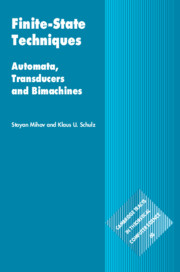Refine search
Actions for selected content:
13 results
Regularity of quasigeodesics characterizes hyperbolicity
-
- Journal:
- Proceedings of the Royal Society of Edinburgh. Section A: Mathematics , First View
- Published online by Cambridge University Press:
- 11 April 2025, pp. 1-14
-
- Article
-
- You have access
- Open access
- HTML
- Export citation
Weighted synchronous automata
-
- Journal:
- Mathematical Structures in Computer Science / Volume 32 / Issue 9 / October 2022
- Published online by Cambridge University Press:
- 25 January 2023, pp. 1234-1253
-
- Article
- Export citation
2 - Monoidal Finite-State Automata
- from Part I - Formal Background
-
- Book:
- Finite-State Techniques
- Published online:
- 29 July 2019
- Print publication:
- 01 August 2019, pp 23-42
-
- Chapter
- Export citation
11 - Constructing Finite-State Devices for Text Rewriting
- from Part II - From Theory to Practice
-
- Book:
- Finite-State Techniques
- Published online:
- 29 July 2019
- Print publication:
- 01 August 2019, pp 279-297
-
- Chapter
- Export citation

Finite-State Techniques
- Automata, Transducers and Bimachines
-
- Published online:
- 29 July 2019
- Print publication:
- 01 August 2019
Incremental DFA minimisation∗
-
- Journal:
- RAIRO - Theoretical Informatics and Applications / Volume 48 / Issue 2 / April 2014
- Published online by Cambridge University Press:
- 21 January 2014, pp. 173-186
- Print publication:
- April 2014
-
- Article
- Export citation
Regularity of languages defined by formal series with isolatedcut point∗
-
- Journal:
- RAIRO - Theoretical Informatics and Applications / Volume 46 / Issue 4 / October 2012
- Published online by Cambridge University Press:
- 02 August 2012, pp. 479-493
- Print publication:
- October 2012
-
- Article
- Export citation
Closure properties of hyper-minimized automata
-
- Journal:
- RAIRO - Theoretical Informatics and Applications / Volume 45 / Issue 4 / November 2011
- Published online by Cambridge University Press:
- 14 November 2011, pp. 459-466
- Print publication:
- November 2011
-
- Article
- Export citation
Translation from classical two-way automata to pebble two-way automata
-
- Journal:
- RAIRO - Theoretical Informatics and Applications / Volume 44 / Issue 4 / October 2010
- Published online by Cambridge University Press:
- 28 February 2011, pp. 507-523
- Print publication:
- October 2010
-
- Article
- Export citation
Extending regular expressionswith homomorphic replacement
-
- Journal:
- RAIRO - Theoretical Informatics and Applications / Volume 44 / Issue 2 / April 2010
- Published online by Cambridge University Press:
- 26 January 2010, pp. 229-255
- Print publication:
- April 2010
-
- Article
- Export citation
Deterministic blow-ups of minimal NFA's
-
- Journal:
- RAIRO - Theoretical Informatics and Applications / Volume 40 / Issue 3 / July 2006
- Published online by Cambridge University Press:
- 18 October 2006, pp. 485-499
- Print publication:
- July 2006
-
- Article
- Export citation
Complexity results for prefix grammars
-
- Journal:
- RAIRO - Theoretical Informatics and Applications / Volume 39 / Issue 2 / April 2005
- Published online by Cambridge University Press:
- 15 April 2005, pp. 391-401
- Print publication:
- April 2005
-
- Article
- Export citation


